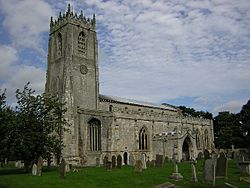Blyth Priory facts for kids

Blyth Church, which incorporates part of the former priory church
|
|
| Monastery information | |
|---|---|
| Order | Benedictine |
| Established | 1088. Refounded in 1409. |
| Disestablished | 1409 and 1536 |
| Mother house | Until 1409, St. Katharine's, Rouen, France |
| People | |
| Founder(s) | Roger de Builli |
| Site | |
| Location | Nottinghamshire, England |
| Coordinates | 53°22′44″N 1°03′48″W / 53.3788262°N 1.0634583°W |
| Visible remains | Part of the Priory Church incorporated in St. Mary and St. Martin’s Church, Blyth |
Blyth Priory was a special religious building, like a monastery, located in Nottinghamshire, England. It was dedicated to St Mary the Virgin. Monks lived and prayed here for hundreds of years.
Contents
The Story of Blyth Priory
Blyth Priory was started in 1088 by a person named Roger de Busli. It was home to Benedictine monks.
A Priory with French Connections
For a long time, Blyth Priory was connected to a bigger monastery in Rouen, France. This meant it was an "alien house," or dependent on a foreign parent monastery. When England and France were at war, the King of England would take control of the priory. Many monks sent to Blyth were French.
Changes and Dissolutions
The original priory was closed down in 1409. However, it was quickly reopened as an independent priory. This meant it no longer had to answer to the French monastery.
But then, in 1536, the priory was closed again. This happened during King Henry VIII's time, as part of his big plan called the Dissolution of the Monasteries. During this time, many monasteries across England were closed down.
What Remains Today
The church part of Blyth Priory was built in the late 1000s. Over the years, it was changed and updated many times.
From Priory to Parish Church
In the 1400s, some parts of the priory church were blocked off and later taken down. A new tower was also added. The south side of the church had been used by local people since the 1200s.
After the priory was closed, the remaining parts of the church were used to create the local parish church, which is now called St. Mary and St. Martin’s Church, Blyth. This church was also changed and fixed up in the 1800s and 1900s.
The Monastery Buildings
The other buildings where the monks lived were located north of the church. These buildings were separated from the church by a cloister, which is an open area with covered walkways.
After the priory closed, many of these monastic buildings fell into ruin. About a hundred years later, some were fixed up to become a private house. However, this house was completely torn down around 1670. A new house, called Blyth Hall, was built in its place. Only the cellar of the old priory was kept in the new hall.
By 1951, Blyth Hall was in bad shape. It was finally demolished in the 1970s, along with the last pieces of the old monastic buildings. Today, the area where the priory once stood is a housing estate. Even though it's now houses, the site is still protected as a scheduled monument, meaning it's an important historical place.


